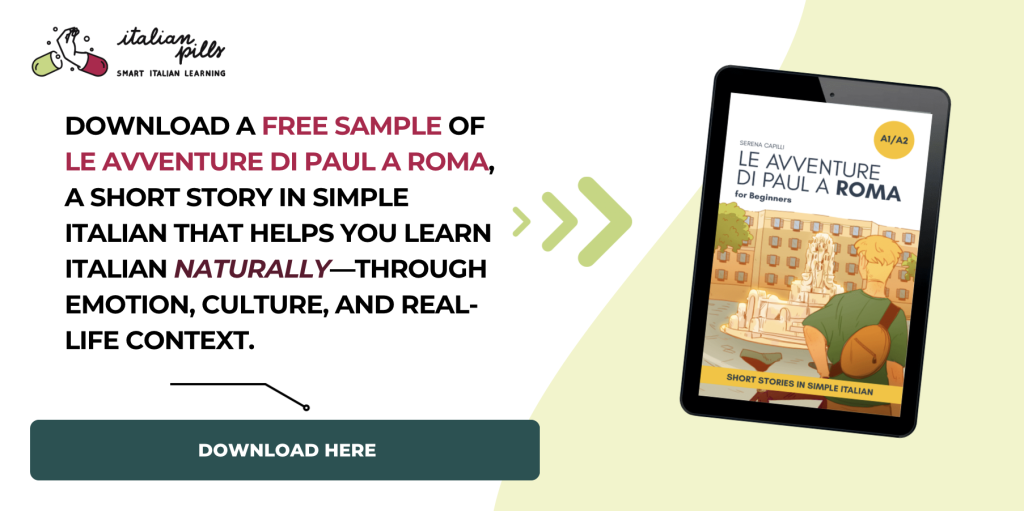(and fall in love with learning Italian through stories and culture)
Stop Learning Italian Words in Isolation
When you learn Italian, it’s easy to fall into the trap of chasing vocabulary lists, flashcards, or social media phrases:
50 words for food, 10 phrases for travelling to Italy, and so on.
But words learned in isolation are like people without a piazza: single puzzle pieces with no image to complete.
To build a beautiful picture, you need to connect them.
If you truly want to own new Italian words, the best tool isn’t a flashcard app or a memorized list.
It’s context: a story, a magazine, a meaningful text that helps you connect the words emotionally and visually.
Through reading repeatedly, you’ll meet familiar words in new combinations and situations.
Do this over time, and you’ll start to speak Italian through intuition, not memorization.
Why Reading Builds Real Vocabulary
When you read (at your level — that’s paramount!), you encounter words you already “know,” but now they appear in different phrases, moods, and conjugations.
That’s where the magic happens.
Reading gives you something a list never can: context, emotion, images, and stories.
Take for example cuore — heart.
In one of my short stories, a character says:
“Mi batte forte il cuore.”
Later, another says:
“Segui il tuo cuore.”
The same word but two different feelings, two new memories in your mind.
This kind of natural exposure is what strengthens your vocabulary. You can experience it through easy readers, short stories, or any authentic text written for learners, like Piazzetta Italiana, my language magazine in accessible Italian, or my graded story collections.

How to Read Italian for Vocabulary Growth
Here’s a simple way to use Italian books — even short ones — to grow your vocabulary naturally:
- Read first for meaning, not every word. Enjoy the story; don’t stop every two lines.
- Underline chunks or phrases. These “word combinations” are the real building blocks of fluency.
- Guess from context. Don’t look up every unfamiliar word — train your brain to infer meaning.
- Write down phrases, not single words. It’s better to learn fare una passeggiata than just passeggiata.
- Reread. When you read a short piece several times — for example, a page from Piazzetta Italiana — your brain cements the rhythm and vocabulary.
- Speak or write about what you read. Talking about stories helps move new words from passive memory to active use.
Remember: to truly absorb and use new vocabulary, you need to meet it at least 20 times, in different contexts, feelings, and forms.
Choosing the Right Italian Books
Start small. A good book at your level will teach you much more than a difficult one you can’t finish.
A1–A2 (Beginners)
Begin with graded readers and short stories like mine, written in simple, real Italian.
You can find them on my Amazon Author Page or get the PDF copies directly from me here.
B1–B2 (Intermediate)
Read slightly more advanced short stories or magazines.
Try Piazzetta Italiana, my lifestyle magazine in intermediate Italian — you’ll connect with modern Italy through travel, art, food, and culture.
You can also explore my collections such as Gioielli e Caffè e Firenze, easy-reader stories created for intermediate learners.
Advanced Learners
Move on to authentic Italian novels, contemporary authors, or Italian newspapers and magazines.
Common Mistake to Avoid
The most common mistake I’ve seen as a language teacher is choosing the wrong content level:
- Too easy → no challenge, no progress.
- Too hard → frustration and forgetfulness.
The key is comprehensible input — content that’s just above your current level, where you understand 80–90% but still discover something new.
Where to Find the Right Italian Books
Here are a few ideas to start your reading journey:
- Piazzetta Italiana – a quarterly language magazine in simple Italian, full of engaging stories and articles about real Italian life and culture.
- Short Stories in Simple Italian for All Levels – my collection of graded stories with audio, grammar, and vocabulary notes designed to help you learn naturally through reading.
- Best Short Stories in Italian for Beginners: discover easy Italian stories that build confidence and vocabulary step by step.
- Best Short Stories in Italian for Intermediate Learners: explore richer language and culture while improving fluency through storytelling.

In the End
Reading is the most powerful immersion practice you can reproduce anywhere.
Every page gives you the repeated, meaningful exposure your brain needs to think in Italian.
Read with curiosity. Revisit stories. Let words find you in context.







